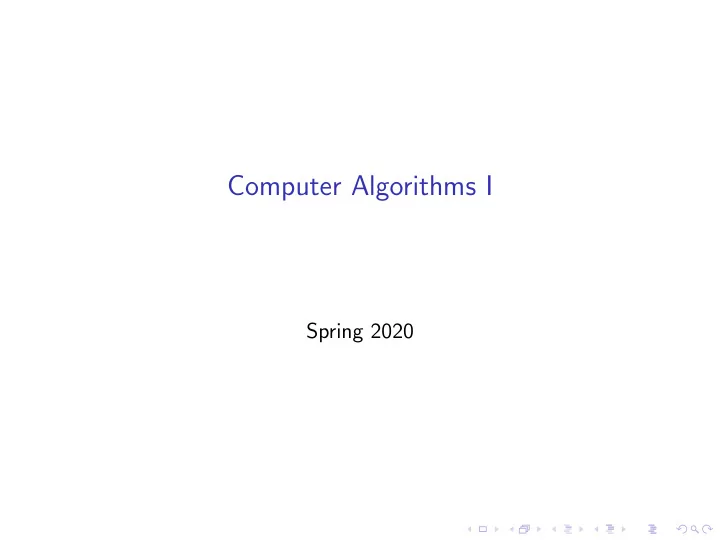

Computer Algorithms I Spring 2020
Flow networks G = ( V , E ) directed graph, source s , sink t capacity of edges: c ( u , v ) ≥ 0 flow along edges: 0 ≤ f ( u , v ) ≤ c ( u , v )
Maximum flow problem flow conservation constraint: if u � = s , t then � � f ( v , u ) = f ( u , v ) v ∈ V v ∈ V flow value: � � | f | = f ( s , v ) − f ( v , s ) v ∈ V v ∈ V flow in example has value 19 given a network with capacities, find a flow of maximal value!
Algorithm idea improving a flow: given a flow, modify it to get a flow of larger value! what if no further improvement is possible? show that then the flow is optimal!
How to improve a flow? try send more flow along the edges! the flow can be increased by 2 units along the path no such improvement possible in the previous case, and flow is not optimal!
Residual network forward / backward edge
Augmenting path augmenting path: s − t path in residual network
Improved flow new flow has value 23 in the residual network no augmenting path so flow is optimal (?)
Ford-Fulkerson algorithm
Definitions (simplified) residual capacity of edges and reversed edges � c ( u , v ) − f ( u , v ) ( u , v ) ∈ E c f ( u , v ) = f ( v , u ) ( v , u ) ∈ E residual network: edges and reverse edges with c f > 0 augmenting path: s → t path p in residual network residual capacity of path p : c f ( p ) = min { c f ( u , v ) : ( u , v ) ∈ p } augmented flow: � f ( u , v ) + c f ( p ) ( u , v ) ∈ p ( f ↑ p )( u , v ) = f ( u , v ) − c f ( p ) ( v , u ) ∈ p value of augmented flow = value of flow + c f ( p )
After augmentation we get a flow
Cuts net flow across cut: f ( S , T ) = (12 + 0 + 19) − (1 + 7) = 23 capacity of cut: c ( S , T ) = 13 + 9 + 20 = 42 f ( S , T ) ≤ c ( S , T ) for every cut ( S , T )
Max-flow min-cut theorem Theorem TFAE 1. f is a maximum flow 2. there is no augmenting path in the residual network for f 3. | f | = c ( S , T ) for some cut ( S , T ) 1 ⇒ 2: any augmenting path could be used to improve | f | 2 ⇒ 3: let S be the vertices reachable from s in the residual network for f , and T be the rest 3 ⇒ 1: no flow can have value > c ( S , T )
An example no running time bound in terms of | V | for irrational capacities may not even terminate! for integer capacities terminates: every augmentation is at least 1 (also for rational)
Edmonds - Karp algorithm augment along shortest augmenting path running time: O ( | V || E | 2 ) there are more efficient algorithms: O ( | V | 3
Recommend
More recommend